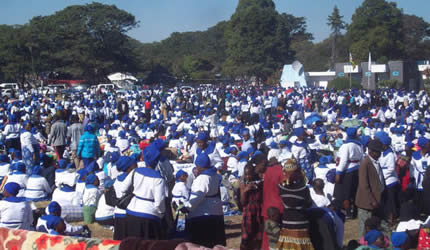Climate change: Migration not the way
Yet a ground-breaking study released on November 28 reveals a more nuanced relationship between climate variability and migration, which could provide insight into how events might transpire in the coming years.
The study, carried out by Care International and the UN University (UNU) in eight countries in Asia, Africa and Latin America, reveals that in nearly all instances where rains have become too scarce for farming, people have migrated — but within the national borders.
The project also considered possible future scenarios in Tanzania, where even scarcer rains over the next 25 years were projected to double migration from vulnerable households.
The project’s researchers hope their findings will inform the UN Framework Convention on Climate Change (UNFCCC) talks, currently taking place in Doha, by persuading participants to speed up efforts to cut greenhouse gas emissions and develop effective policies to adapt to rising temperatures.
An unanswered question
The three-year research project, Where the rain falls: climate change, hunger and human mobility, covered over 1 300 households and 2 000 individuals in Bangladesh, India, Ghana, Guatemala, Peru, Tanzania, Thailand and Vietnam.
Rainfall variability represents the impact of climate change for people living in rural areas.
Over 95 percent of Africa’s agriculture is rain-fed and the percentage is as high for most of Asia, leaving populations there particularly vulnerable to changes in rain patterns.
The project shows that, as rains become more variable, food often becomes scarcer in rural developing areas, forcing many to move.
It is one of the first empirical efforts to explore how poor households use migration as a risk management strategy to deal with climate stressors and food insecurity.
The study also offers insight into how households adjust their behaviour in the face of these changes, which could inform how policymakers support rural communities.
One of the most striking things was that these households send migrants during the hunger season, with the aim of obtaining food or obtaining money to buy food.
If the head of household fails to find food or the means to buy it, the family back home suffers.
“Until recently, research on environmental change and human mobility has made the point that environmental factors do play a role in migration, but have not been more specific,” explained Koko Warner, the scientific director of the project at UNU, in an email to IRIN.
“There has also been a debate about whether migration is a ‘positive’ form of adaptation, for example, migrants go out and send remittances back home, which can then be used to build resilience, or a ‘negative’ sign that adaptation is not really working in areas of origin (or) that people have few other good options.
“Our research shows that the answer to the debate lies in the vulnerability of the household and its sensitivity to climatic factors. Almost all the households we surveyed — almost 1 400 across eight districts in eight countries — were poor and land-scarce. And almost all of the households use migration (when rains and food becomes scarce). But they use migration in different ways.”
A nuanced set of responses
Though there was variation across countries and even within districts, generally the more resilient households with greater access to social networks and education “had found ways to diversify their livelihoods — in essence these families have better risk-management options,” Warner wrote.
“Those resilient households use migration to reduce their exposure to climatic variability.
“In those households, migrants are in their mid-20s, single, move temporarily and send remittances back home. Those resilient households use migration to invest in even more livelihood diversification, education, health and other activities that put them on a positive path to human development.”
These people had other adaptation strategies, as well, with many moving seasonally and often to non-agricultural jobs in cities or other countries.
Earlier this year, IRIN found that the ability to diversify household income sources in Niger made some pastoralists more resilient than others.
1. Many households use migration as an attempt to manage risk but do not flourish — they are found in countries with less food security and fewer options to diversify their incomes. They move within their countries seasonally to find work, often as agricultural labourers.
2. Others use migration as an erosive coping strategy — as a matter of human security — when few other options exist. These households are found in areas where food is even scarcer. They often move during the “hunger” season to other rural areas in their regions in search of food or work.
3. Lastly, the study found “households that are trapped and cannot move, and are really at the very margins of existence,” according to Warner. These households do not have the capacity to migrate.
“For me, one of the most striking things was that these households send migrants during the hunger season, with the aim of obtaining food or obtaining money to buy food.
“If the head of household fails to find food or the means to buy it, the family back home suffers and vulnerability is exacerbated,” she wrote.
Loss and damage
Researchers hope their study will influence the UNFCCC’s discussion about the possible development of a mechanism to guide how countries deal with losses and damages caused by climate change.
“A loss and damage mechanism should support measures that enable particularly poor populations to retain or transfer risk,” notes the project’s global policy report.
With no rains and food Hani Issa was thinking of leaving her village in Niger earlier in 2012 for good Many developing countries that expect to see their populations migrate in response to climate change are looking for answers “about what kinds of policy and institutional/governance/legal options they may have to manage mobility,” said Warner.
“Essentially nothing is in place to address the needs of mobile people (and stranded people) if they cannot reasonably return to their areas of origin,” she continued.
The project has also found “that loss and damage today goes beyond quantifiable, formal sector economic impacts that can be measured in terms of physical assets or gross domestic product.” These losses could pertain to the rights of individuals to food and dignity.
“Failing to measure these non-economic losses means that they could elude policy attention. Without explicit efforts to assess these kinds of losses, policymakers may have a myopic view of both impacts and solutions,” Warner said.
Kevin Henry, the project’s coordinator for Care France, said in a statement upon the report’s release, “If national and global policymakers and practitioners do not act quickly — both to mitigate global warming and support rural communities to adapt — food insecurity and emigration from areas most negatively affected by climate change are likely to grow in the coming decades, with all the humanitarian, political and security consequences that entails.” — IRIN.








Comments